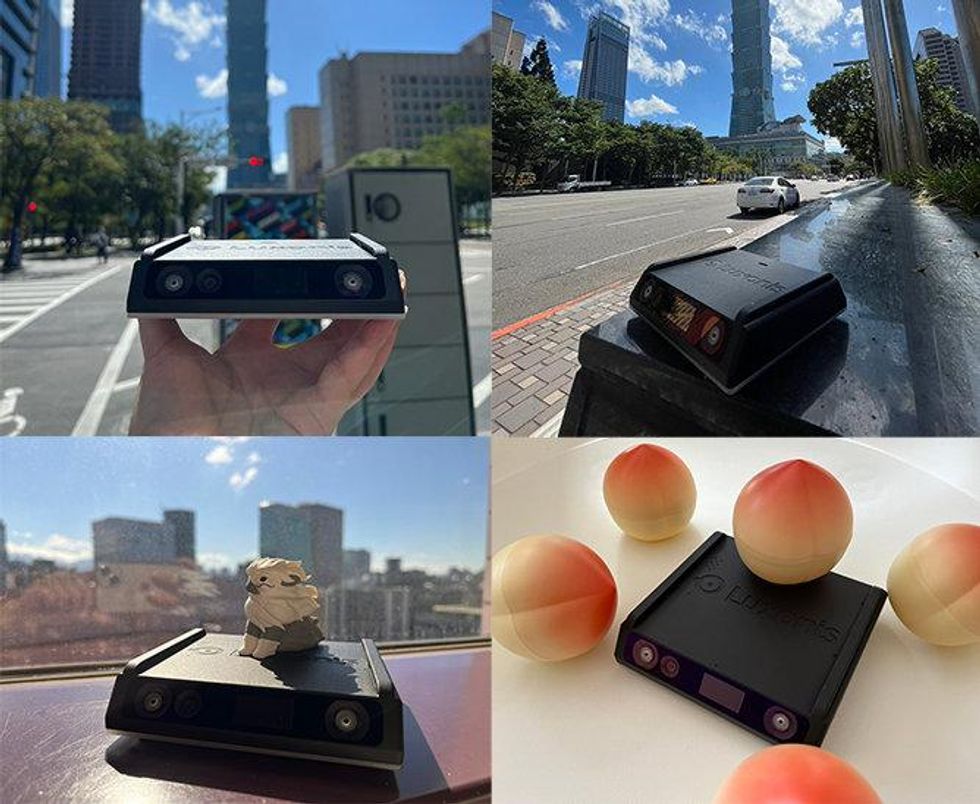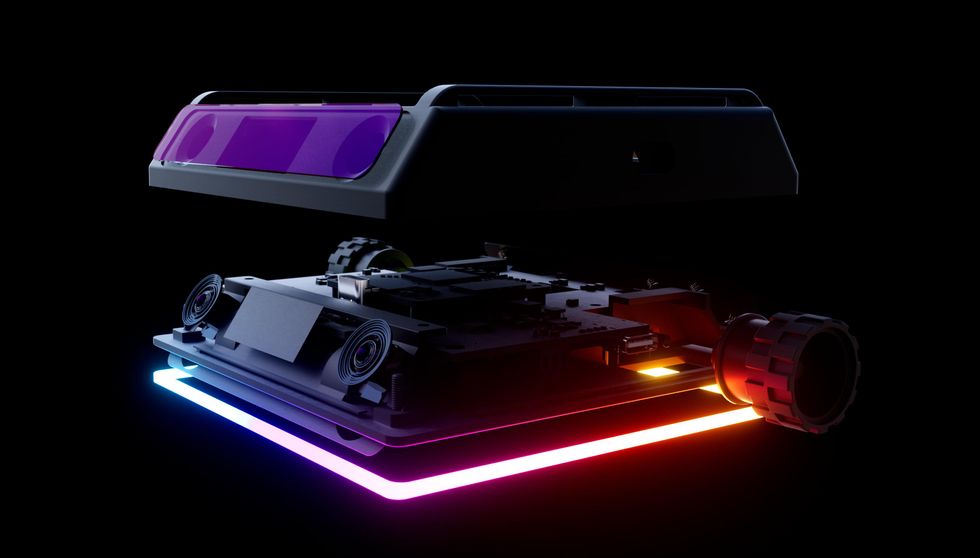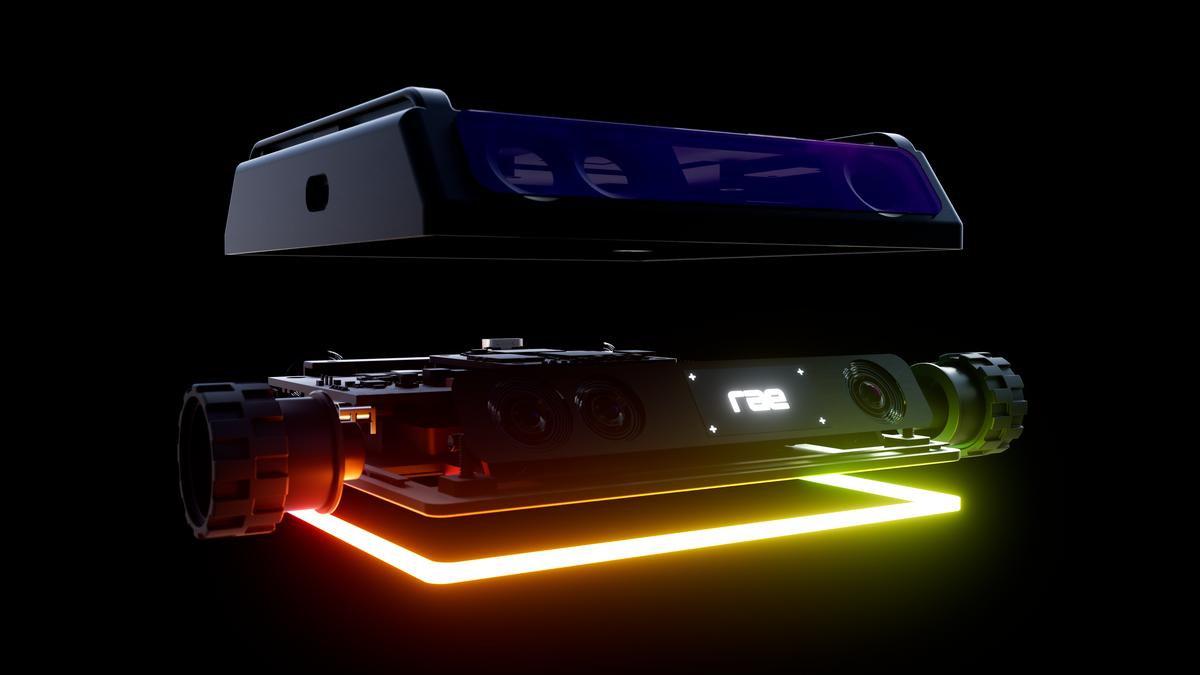Luxonis, a sensor company best known for its OAK line of stereo depth cameras, has decided to take a crack at something a little more complicated and a lot more RGB. It’s just launched a Kickstarter for Rae, a pint-size open-source mobile robot with an integrated depth camera that combines accessible apps with ROS 2 and is somehow also kind of affordable.
“Rae,” which is technically “rae,” but I can’t bring myself to not capitalize it, stands for “robotics access for all.” The video doesn’t really communicate how small it is: it’s only 120 millimeters on a side and weighs just 400 grams (even though it’s made of Actual Metal), designed to be easy to futz with on your desk.
A stereo camera provides depth data, with a 4K camera for streaming video, and there’s another stereo pair on the back. There’s also a small LCD display. Rails across the top make it easy to mount accessories. Connectivity is via USB-C, both for communications and charging, and it’s got Wi-Fi and Bluetooth along with a mic and speaker. And the programmable RGB is unmissable. The wheels aren’t big (the robot itself isn’t big, to be fair), but Luxonis says that it can still handle carpet and even grass and gravel with its 4 mm of ground clearance. An integrated battery is good for 1 hour of operation, with 1 hour of charging, but you can add more batteries as a payload (maxing out at about 2 kilograms). No integrated docking capability, though.
On the software side, Rae comes with a whole bunch of computer vision, AI, and machine-learning apps. You get stuff like mapping, facial recognition, and 3D object localization and tracking, and it’ll play hide-and-seek with you right out of the box, among other relatively simple applications. It’s cloud-based, so you can access your robot remotely, and you can build your own applications for Rae and share them with other users. To what extent folks will actually end up doing this is uncertain—these sorts of robot app-store things haven’t been all that successful in the past, so as you’re thinking about what you might do with Rae, I’d focus on what it comes with rather than what others could potentially make for it.

Thanks to Luxonis superfans, the Kickstarter campaign was fully funded in about 8 minutes, and the superearly bird version of the robot is sold out. This is a shame, because it was a shockingly cheap US $299. As of now-ish, Rae has more than 400 backers and is nearing $200,000 on Kickstarter, close to 10X-ing its goal. Rae is currently available for a pledge of $399 (plus shipping), which is still quite good, especially if you look at what else is out there.
The obvious comparison here is to the TurtleBot, which is arguably more capable and more expandable and could be a better learning platform for ROS but is also way more expensive—the most basic version of the new TurtleBot 4 is well over $1000. Even the TurtleBot 3 is $600, and only comes with a planar lidar. The next step down is something like a Create 3, which is $300 but has no depth sensor on it at all, unless you count the one that keeps it from falling down stairs. And there’s something to be said for Rae’s small size, too—it just looks easy and convenient, doesn’t it?
“We want Rae to be really, really easy to use for somebody that is not necessarily an advanced roboticist,” Luxonis’s chief operating officer Bradley Dillon tells us. “Our thinking was, what if we had a really compact all-in-one platform that people could create with?” Unlike TurtleBot, Rae is tightly integrated, which I think makes it less intimidating, especially for folks without a lot of robotics experience. And while Rae is absolutely ROS 2 compatible, all of the included apps, and the fact that you can interface with the robot from your phone and get it to immediately do stuff, makes it a lot more accessible right out of the box. If you want to get all up in its software guts, you’re welcome to, but unlike with TurtleBot, doing so is not at all required.
“We think that students from elementary to high school could get into robotics with Rae.” —Bradley Dillon, Luxonis’s COO
The tricky part about making any robot part of a curriculum is that generally you need a curriculum, which is a really, really big challenge. Tutorials, how-to guides, sample programs and code, ideally a progressive interface like Scratch or Blockly, an active community for answering questions—this is all an enormous investment of time and resources, but without it, asking educators to come up with all of it on their own is generally a nonstarter.
Dillon acknowledges this problem. “We can’t solve all aspects of accessibility at once, but we do feel like we're lowering the barrier to entry quite a bit,” he says. “And we think that as the community size grows, it will help drive that barrier down even further.” This is really something that Rae does have going for it—the low cost should get it into the hands of many more people with a much wider spectrum of robotics experience, and if that prompts Luxonis (or someone else) to put some serious work into helping educators (and also the rest of us novices) use Rae as an entry point, that would be very cool.

If all goes well, Rae should start shipping to backers sometime in May, and we’ll see if we can get our hands on one before then for a review. If you’re sold already, the Kickstarter is right here.
Evan Ackerman is a senior editor at IEEE Spectrum. Since 2007, he has written over 6,000 articles on robotics and technology. He has a degree in Martian geology and is excellent at playing bagpipes.



